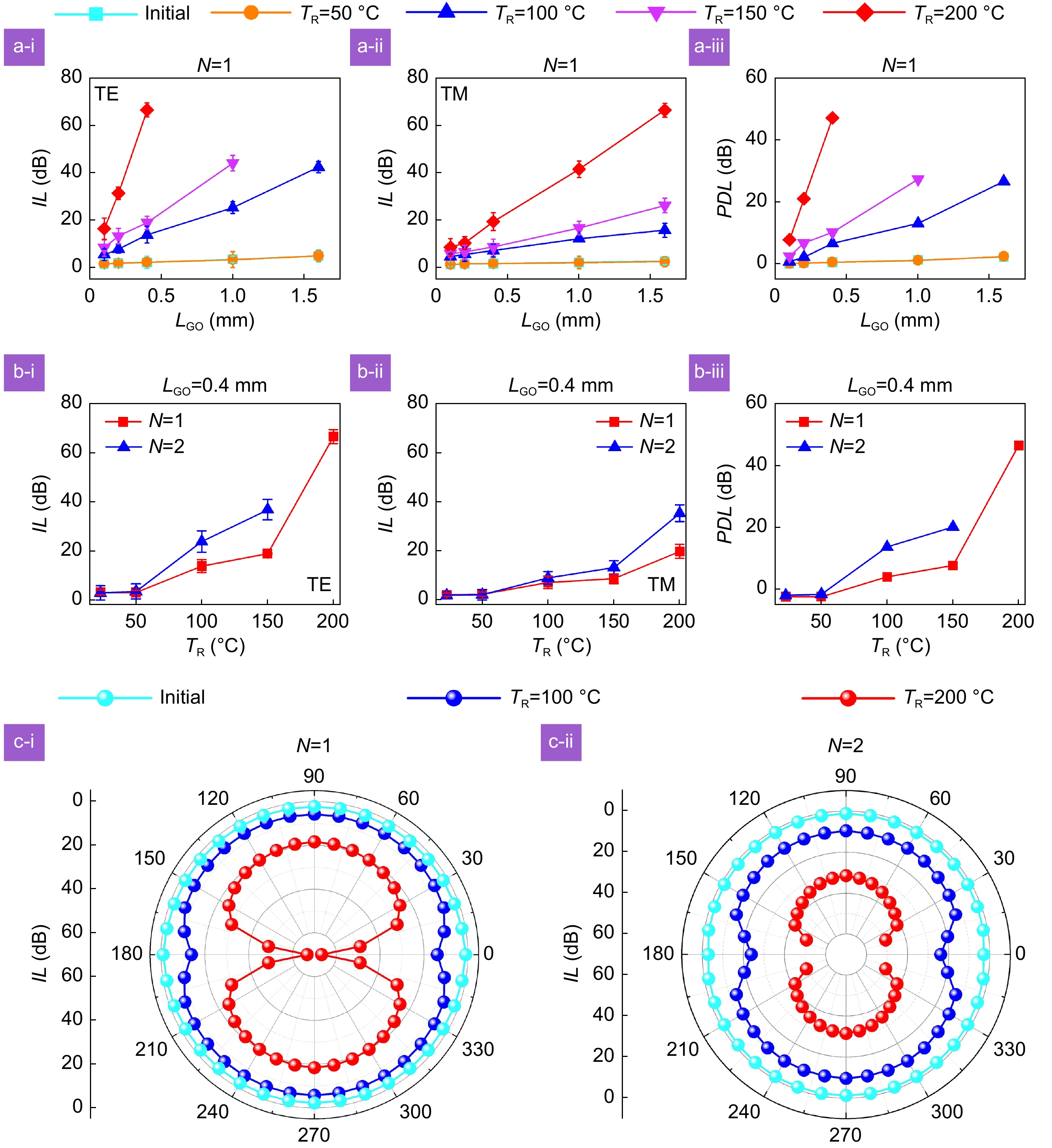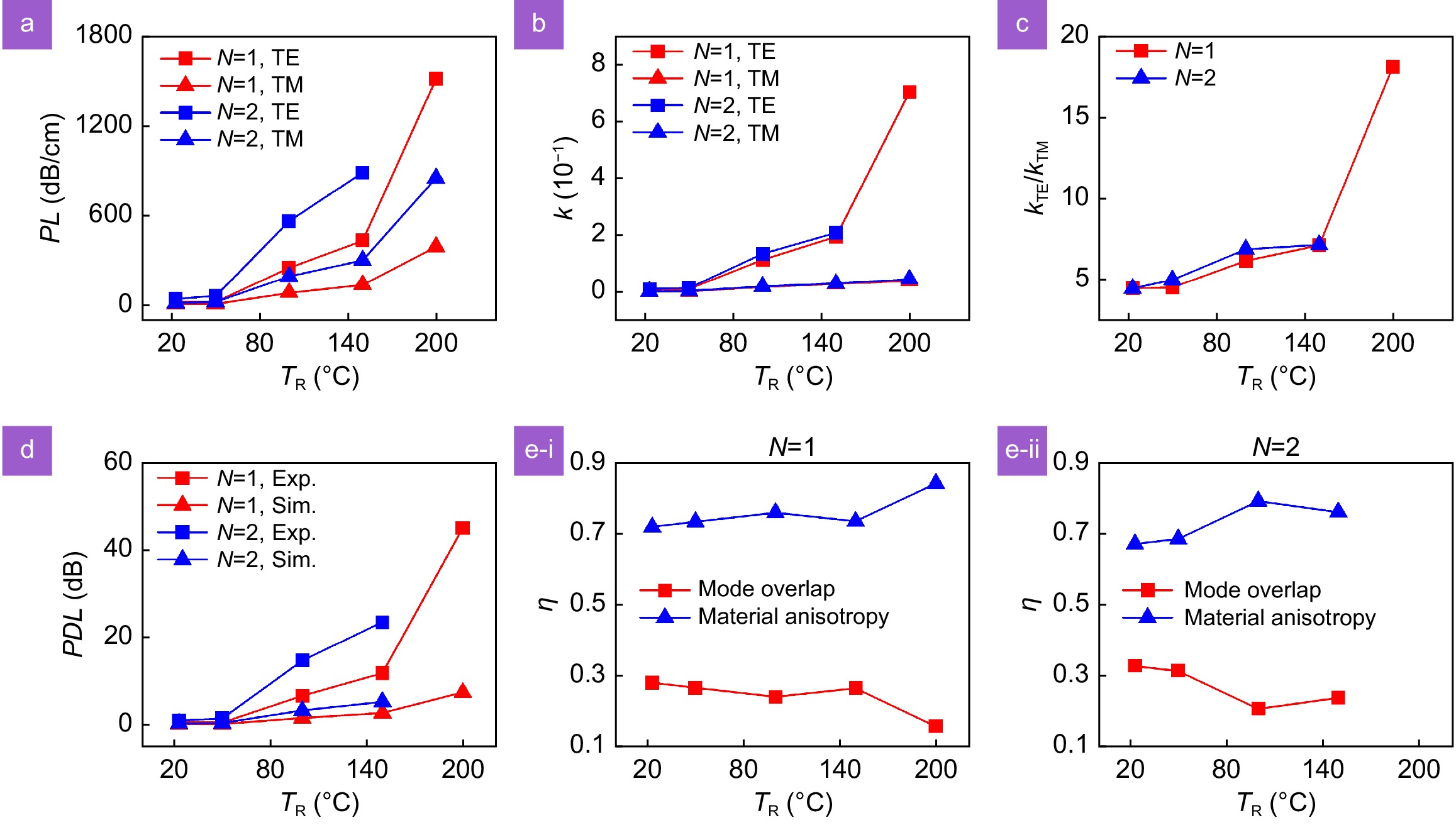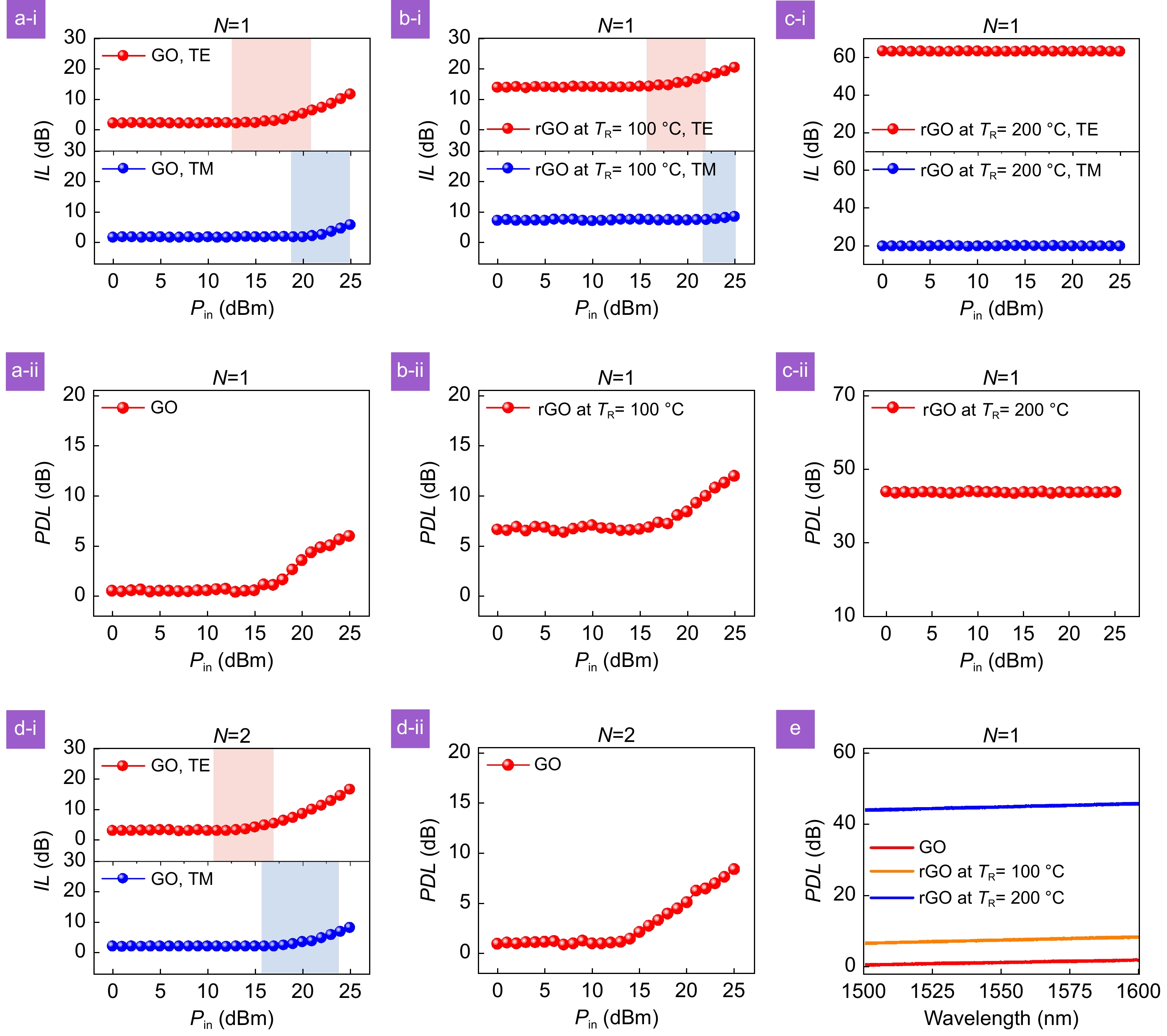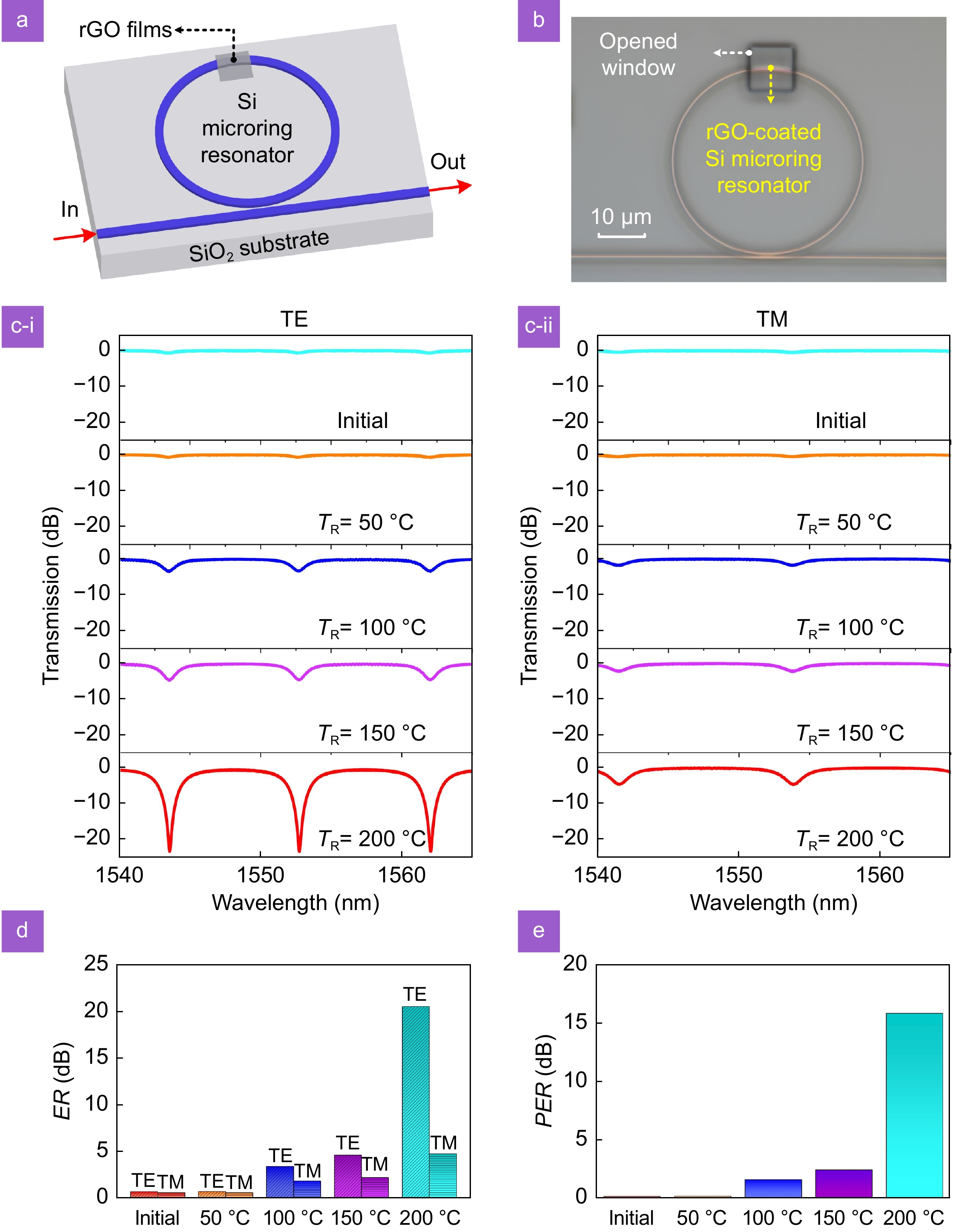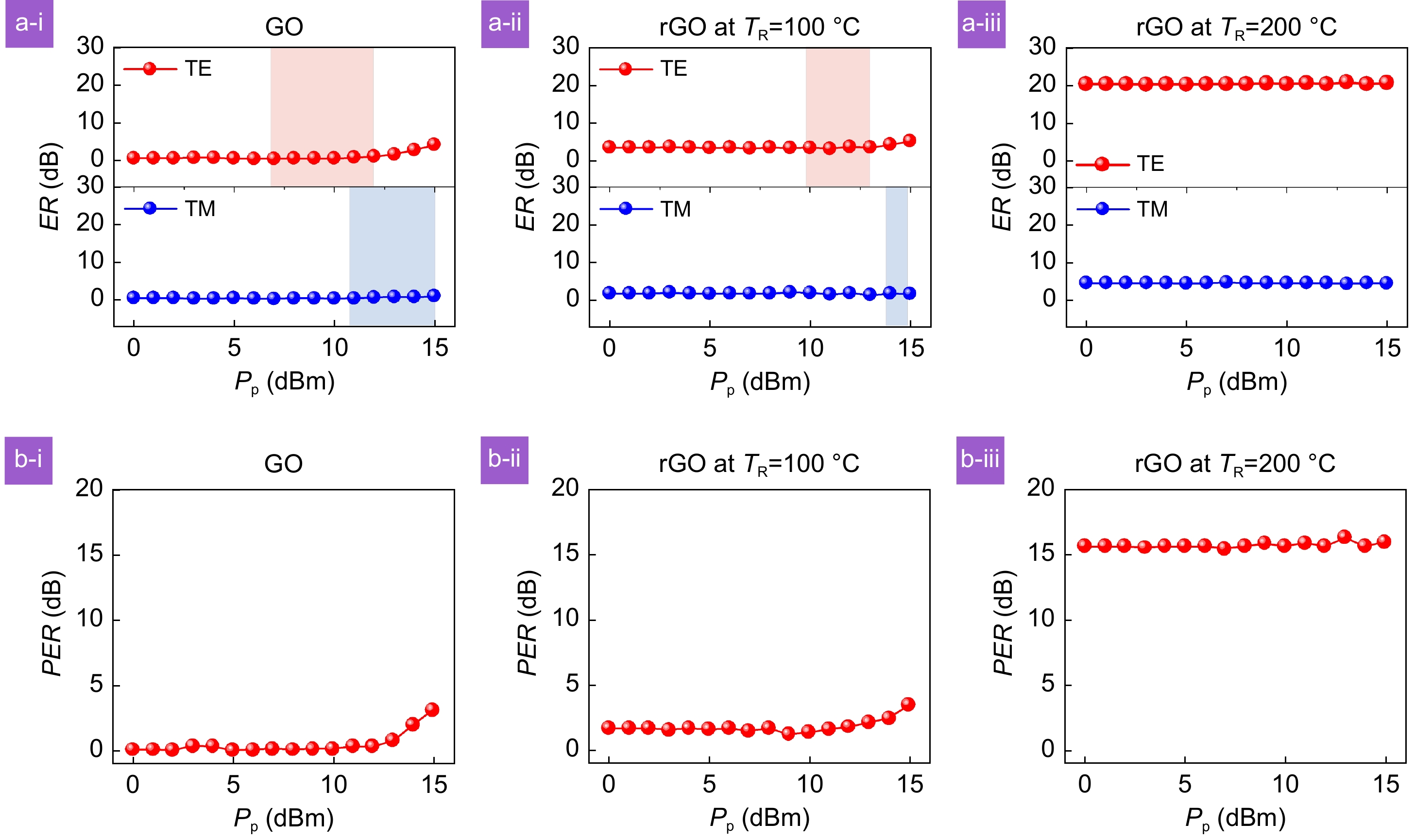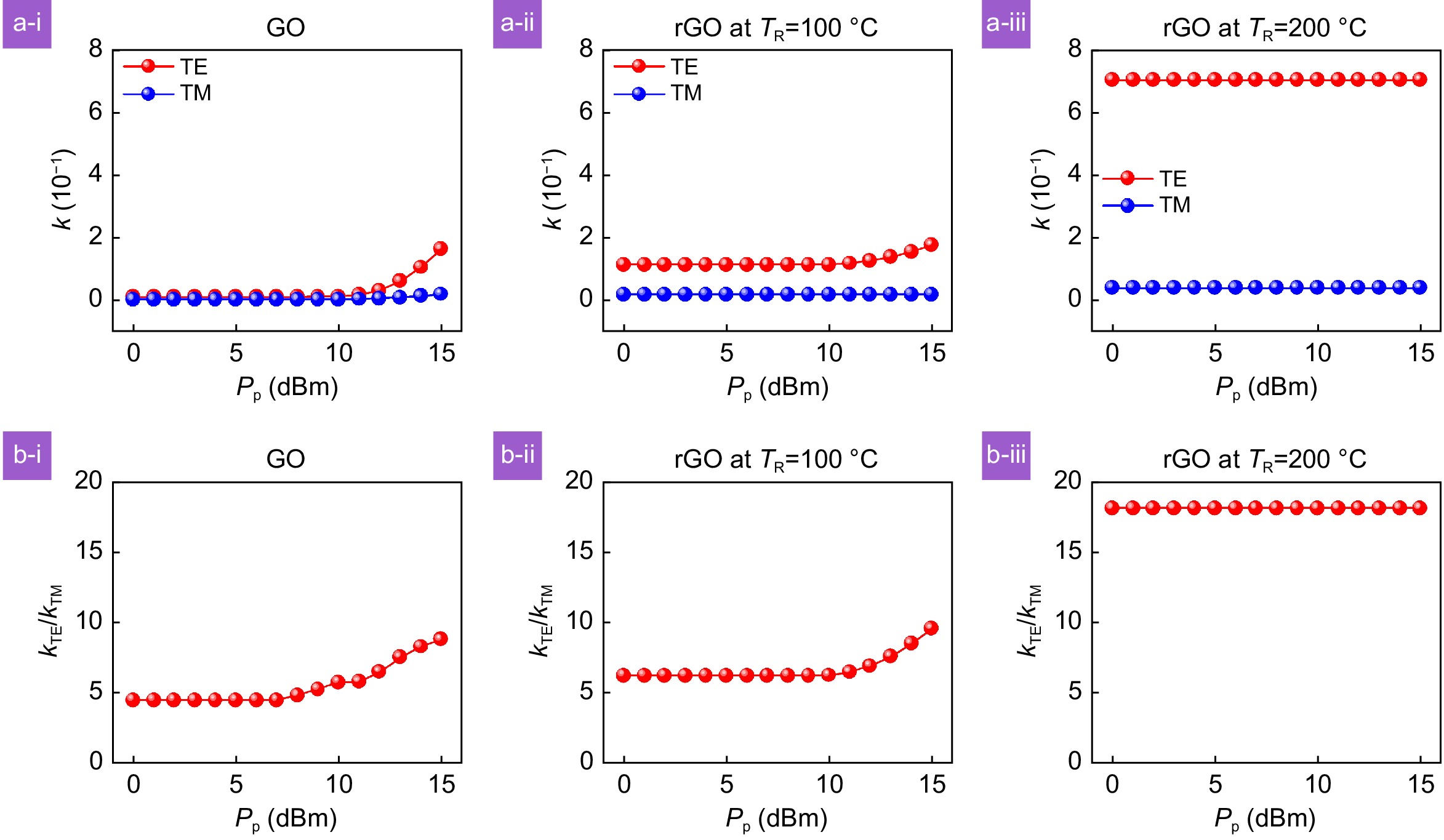| Citation: | Hu JK, Wu JY, Jin D et al. Integrated photonic polarizers with 2D reduced graphene oxide. Opto-Electron Sci 4, 240032 (2025). doi: 10.29026/oes.2025.240032 |
-
Abstract
Optical polarizers, which allow the transmission of specific polarization states, are essential components in modern optical systems. Here, we experimentally demonstrate integrated photonic polarizers incorporating reduced graphene oxide (rGO) films. 2D graphene oxide (GO) films are integrated onto silicon waveguides and microring resonators (MRRs) with precise control over their thicknesses and sizes, followed by GO reduction via two different methods including uniform thermal reduction and localized photothermal reduction. We measure devices with various lengths, thicknesses, and reduction degrees of GO films. The results show that the devices with rGO exhibit better performance than those with GO, achieving a polarization-dependent loss of ~47 dB and a polarization extinction ratio of ~16 dB for the hybrid waveguides and MRRs with rGO, respectively. By fitting the experimental results with theory, it is found that rGO exhibits more significant anisotropy in loss, with an anisotropy ratio over 4 times that of GO. In addition, rGO shows higher thermal stability and greater robustness to photothermal reduction than GO. These results highlight the strong potential of rGO films for implementing high-performance polarization selective devices in integrated photonic platforms.-
Keywords:
- integrated optics /
- 2D materials /
- graphene oxide /
- optical polarizers
-

-
References
[1] Bao QL, Zhang H, Wang B et al. Broadband graphene polarizer. Nat Photonics 5, 411–415 (2011). doi: 10.1038/nphoton.2011.102 [2] He C, He HH, Chang JT et al. Polarisation optics for biomedical and clinical applications: a review. Light Sci Appl 10, 194 (2021). doi: 10.1038/s41377-021-00639-x [3] Chipman R, Lam WST, Young G. Polarized Light and Optical Systems (CRC Press, Boca Raton, 2018). [4] Dai DX, Liu L, Gao SM et al. Polarization management for silicon photonic integrated circuits. Laser Photonics Rev 7, 303–328 (2013). doi: 10.1002/lpor.201200023 [5] Rahnama A, Dadalyan T, Mahmoud K et al. In-fiber switchable polarization filter based on liquid crystal filled hollow-filament bragg gratings. Adv Opt Mater 9, 2100054 (2021). doi: 10.1002/adom.202100054 [6] Saitoh E, Kawaguchi Y, Saitoh K et al. TE/TM-pass polarizer based on lithium niobate on insulator ridge waveguide. IEEE Photonics J 5, 6600610 (2013). doi: 10.1109/JPHOT.2013.2250938 [7] Wang J, Yang YJ, Fazal IM et al. Terabit free-space data transmission employing orbital angular momentum multiplexing. Nat Photonics 6, 488–496 (2012). doi: 10.1038/nphoton.2012.138 [8] Bozinovic N, Yue Y, Ren YX et al. Terabit-scale orbital angular momentum mode division multiplexing in fibers. Science 340, 1545–1548 (2013). doi: 10.1126/science.1237861 [9] Serkowski K, Mathewson DS, Ford VL. Wavelength dependence of interstellar polarization and ratio of total to selective extinction. Astrophys J 196, 261–290 (1975). doi: 10.1086/153410 [10] Wang TJ, He QY, Gao JY et al. Efficient electrooptically Q-switched Er: Cr: YSGG laser oscillator-amplifier system with a Glan-Taylor prism polarizer. Laser Phys 16, 1605–1609 (2006). doi: 10.1134/S1054660X06120024 [11] Guan XW, Chen PX, Chen ST et al. Low-loss ultracompact transverse-magnetic-pass polarizer with a silicon subwavelength grating waveguide. Opt Lett 39, 4514–4517 (2014). doi: 10.1364/OL.39.004514 [12] Huang Y, Zhu SY, Zhang HJ et al. CMOS compatible horizontal nanoplasmonic slot waveguides TE-pass polarizer on silicon-on-insulator platform. Opt Express 21, 12790–12796 (2013). doi: 10.1364/OE.21.012790 [13] Alam MZ, Aitchison JS, Mojahedi M. Compact and silicon-on-insulator-compatible hybrid plasmonic TE-pass polarizer. Opt Lett 37, 55–57 (2012). doi: 10.1364/OL.37.000055 [14] Zhang YN, Wu JY, Jia LN et al. Advanced optical polarizers based on 2D materials. npj Nanophotonics 1, 28 (2024). doi: 10.1038/s44310-024-00028-3 [15] Lin HT, Song Y, Huang YZ et al. Chalcogenide glass-on-graphene photonics. Nat Photonics 11, 798–805 (2017). doi: 10.1038/s41566-017-0033-z [16] Guo JX, Liu Y, Lin L et al. Chromatic plasmonic polarizer-based synapse for all-optical convolutional neural network. Nano Lett 23, 9651–9656 (2023). doi: 10.1021/acs.nanolett.3c02194 [17] Wang S, Wen S, Deng LZ et al. Metasurface-based solid poincaré sphere polarizer. Phys Rev Lett 130, 123801 (2023). doi: 10.1103/PhysRevLett.130.123801 [18] Novoselov KS, Geim AK, Morozov SV et al. Electric field effect in atomically thin carbon films. Science 306, 666–669 (2004). doi: 10.1126/science.1102896 [19] Zeng MQ, Xiao Y, Liu JX et al. Exploring two-dimensional materials toward the next-generation circuits: from monomer design to assembly control. Chem Rev 118, 6236–6296 (2018). doi: 10.1021/acs.chemrev.7b00633 [20] Xia FN, Wang H, Xiao D et al. Two-dimensional material nanophotonics. Nat Photonics 8, 899–907 (2014). doi: 10.1038/nphoton.2014.271 [21] Novoselov KS, Mishchenko A, Carvalho A et al. 2D materials and van der Waals heterostructures. Science 353, aac9439 (2016). doi: 10.1126/science.aac9439 [22] Kim JT, Choi H. Polarization control in graphene-based polymer waveguide polarizer. Laser Photonics Rev 12, 1800142 (2018). doi: 10.1002/lpor.201800142 [23] Kou JL, Chen JH, Chen Y et al. Platform for enhanced light−graphene interaction length and miniaturizing fiber stereo devices. Optica 1, 307–310 (2014). doi: 10.1364/OPTICA.1.000307 [24] Wu JY, Yang YY, Qu Y et al. Graphene oxide waveguide and micro-ring resonator polarizers. Laser Photonics Rev 13, 1900056 (2019). doi: 10.1002/lpor.201900056 [25] Jin D, Wu JY, Hu JK et al. Silicon photonic waveguide and microring resonator polarizers incorporating 2D graphene oxide films. Appl Phys Lett 125, 053101 (2024). doi: 10.1063/5.0221793 [26] Lim WH, Yap YK, Chong WY et al. Graphene oxide-based waveguide polariser: From thin film to quasi-bulk. Opt Express 22, 11090–11098 (2014). doi: 10.1364/OE.22.011090 [27] Zhuo LQ, Li DQ, Chen WD et al. High performance multifunction-in-one optoelectronic device by integrating graphene/MoS2 heterostructures on side-polished fiber. Nanophotonics 11, 1137–1147 (2022). doi: 10.1515/nanoph-2021-0688 [28] Tan Y, He RY, Cheng C et al. Polarization-dependent optical absorption of MoS2 for refractive index sensing. Sci Rep 4, 7523 (2014). doi: 10.1038/srep07523 [29] Berahim N, Amiri IS, Anwar T et al. Polarizing effect of MoSe2-coated optical waveguides. Results Phys 12, 7–11 (2019). doi: 10.1016/j.rinp.2018.11.034 [30] Yang YY, Zhang YN, Zhang J et al. Graphene metamaterial 3D conformal coating for enhanced light harvesting. ACS Nano 17, 2611–2619 (2023). doi: 10.1021/acsnano.2c10529 [31] Wu JY, Yang YY, Qu Y et al. 2D layered graphene oxide films integrated with micro-ring resonators for enhanced nonlinear optics. Small 16, 1906563 (2020). doi: 10.1002/smll.201906563 [32] Lin KT, Lin H, Yang TS et al. Structured graphene metamaterial selective absorbers for high efficiency and omnidirectional solar thermal energy conversion. Nat Commun 11, 1389 (2020). doi: 10.1038/s41467-020-15116-z [33] Wu JY, Zhang YN, Hu JK et al. 2D graphene oxide films expand functionality of photonic chips. Adv Mater 36, 2403659 (2024). doi: 10.1002/adma.202403659 [34] Hu JK, Wu JY, Liu WB et al. 2D graphene oxide: a versatile thermo-optic material. Adv Funct Mater 34, 2406799 (2024). doi: 10.1002/adfm.202406799 [35] Zhang YN, Wu JY, Jia LN et al. Graphene oxide for nonlinear integrated photonics. Laser Photonics Rev 17, 2200512 (2023). doi: 10.1002/lpor.202200512 [36] Li XW. Laser-induced stretchable bioelectronic interfaces by frozen exfoliation. Opto-Electron Adv 7, 240074 (2024). doi: 10.29026/oea.2024.240074 [37] Loh KP, Bao QL, Eda G et al. Graphene oxide as a chemically tunable platform for optical applications. Nat Chem 2, 1015–1024 (2010). doi: 10.1038/nchem.907 [38] Lim GK, Chen ZL, Clark J et al. Giant broadband nonlinear optical absorption response in dispersed graphene single sheets. Nat Photonics 5, 554–560 (2011). doi: 10.1038/nphoton.2011.177 [39] Luo ZT, Vora PM, Mele EJ et al. Photoluminescence and band gap modulation in graphene oxide. Appl Phys Lett 94, 111909 (2009). doi: 10.1063/1.3098358 [40] Fatkullin M, Cheshev D, Averkiev A et al. Photochemistry dominates over photothermal effects in the laser-induced reduction of graphene oxide by visible light. Nat Commun 15, 9711 (2024). doi: 10.1038/s41467-024-53503-y [41] Bagri A, Mattevi C, Acik M et al. Structural evolution during the reduction of chemically derived graphene oxide. Nat Chem 2, 581–587 (2010). doi: 10.1038/nchem.686 [42] De Silva KKH, Huang HH, Joshi R et al. Restoration of the graphitic structure by defect repair during the thermal reduction of graphene oxide. Carbon 166, 74–90 (2020). doi: 10.1016/j.carbon.2020.05.015 [43] Zhu YW, Murali S, Cai WW et al. Graphene and graphene oxide: synthesis, properties, and applications. Adv Mater 22, 3906–3924 (2010). doi: 10.1002/adma.201001068 [44] Ghofraniha N, Conti C. Graphene oxide photonics. J Opt 21, 053001 (2019). doi: 10.1088/2040-8986/ab10d7 [45] Valentini C, Montes-García V, Livio PA et al. Tuning the electrical properties of graphene oxide through low-temperature thermal annealing. Nanoscale 15, 5743–5755 (2023). doi: 10.1039/D2NR06091D [46] Wu JY, Lin H, Moss DJ et al. Graphene oxide for photonics, electronics and optoelectronics. Nat Rev Chem 7, 162–183 (2023). doi: 10.1038/s41570-022-00458-7 [47] Wei ZQ, Wang DB, Kim S et al. Nanoscale tunable reduction of graphene oxide for graphene electronics. Science 328, 1373–1376 (2010). doi: 10.1126/science.1188119 [48] Voiry D, Yang J, Kupferberg J et al. High-quality graphene via microwave reduction of solution-exfoliated graphene oxide. Science 353, 1413–1416 (2016). doi: 10.1126/science.aah3398 [49] Jiang BQ, Hou YG, Wu JX et al. In-fiber photoelectric device based on graphene-coated tilted fiber grating. Opto-Electron Sci 2, 230012 (2023). doi: 10.29026/oes.2023.230012 [50] Li SS, Fang YN, Wang JF. Control of light–matter interactions in two-dimensional materials with nanoparticle-on-mirror structures. Opto-Electron Sci 3, 240011 (2024). doi: 10.29026/oes.2024.240011 [51] Liu LH, Xu K, Wan X et al. Enhanced optical Kerr nonlinearity of MoS2 on silicon waveguides. Photonics Res 3, 206–209 (2015). doi: 10.1364/PRJ.3.000206 [52] Feng Q, Cong H, Zhang B et al. Enhanced optical Kerr nonlinearity of graphene/Si hybrid waveguide. Appl Phys Lett 114, 071104 (2019). doi: 10.1063/1.5064832 [53] Zhang YN, Wu JY, Yang YY et al. Enhanced kerr nonlinearity and nonlinear figure of merit in silicon nanowires integrated with 2D graphene oxide films. ACS Appl Mater Interfaces 12, 33094–33103 (2020). doi: 10.1021/acsami.0c07852 [54] Yang YY, Lin H, Zhang BY et al. Graphene-based multilayered metamaterials with phototunable architecture for on-chip photonic devices. ACS Photonics 6, 1033–1040 (2019). doi: 10.1021/acsphotonics.9b00060 [55] Zhang YN, Wu JY, Yang YY et al. Enhanced supercontinuum generation in integrated waveguides incorporated with graphene oxide films. Adv Mater Technol 8, 2201796 (2023). doi: 10.1002/admt.202201796 [56] Zhang YN, Wu JY, Yang YY et al. Enhanced self-phase modulation in silicon nitride waveguides integrated with 2D graphene oxide films. IEEE J Sel Top Quantum Electron 29, 5100413 (2023). [57] Shao MR, Ji C, Tan JB et al. Ferroelectrically modulate the Fermi level of graphene oxide to enhance SERS response. Opto-Electron Adv 6, 230094 (2023). doi: 10.29026/oea.2023.230094 [58] Cai H, Cheng YH, Zhang H et al. Enhanced linear absorption coefficient of in-plane monolayer graphene on a silicon microring resonator. Opt Express 24, 24105–24116 (2016). doi: 10.1364/OE.24.024105 [59] Li H, Anugrah Y, Koester SJ et al. Optical absorption in graphene integrated on silicon waveguides. Appl Phys Lett 101, 111110 (2012). doi: 10.1063/1.4752435 [60] Qu Y, Wu JY, Yang YY et al. Enhanced four-wave mixing in silicon nitride waveguides integrated with 2D layered graphene oxide films. Adv Opt Mater 8, 2001048 (2020). doi: 10.1002/adom.202001048 [61] Wu JY, Cao P, Hu XF et al. Nested configuration of silicon microring resonator with multiple coupling regimes. IEEE Photonics Technol Lett 25, 580–583 (2013). doi: 10.1109/LPT.2013.2244589 [62] Bogaerts W, De Heyn P, Van Vaerenbergh T et al. Silicon microring resonators. Laser Photonics Rev 6, 47–73 (2012). doi: 10.1002/lpor.201100017 [63] Feng S, Lei T, Chen H et al. Silicon photonics: from a microresonator perspective. Laser Photonics Rev 6, 145–177 (2012). doi: 10.1002/lpor.201100020 [64] Smith PW, Tomlinson WJ. Solid state: Bistable optical devices promise subpicosecond switching: extensive research in materials and phenomena could lead to their ultimate use in optical communications, despite high power dissipation. IEEE Spectrum 18, 26–33 (1981). [65] Hu JK, Wu JY, Jin D et al. Thermo-optic response and optical bistablility of integrated high-index doped silica ring resonators. Sensors 23, 9767 (2023). doi: 10.3390/s23249767 [66] Arianfard H, Juodkazis S, Moss DJ et al. Sagnac interference in integrated photonics. Appl Phys Rev 10, 011309 (2023). doi: 10.1063/5.0123236 [67] Kim JT, Choi CG. Graphene-based polymer waveguide polarizer. Opt Express 20, 3556–3562 (2012). doi: 10.1364/OE.20.003556 [68] Pei CY, Yang LZ, Wang GC et al. Broadband graphene/glass hybrid waveguide polarizer. IEEE Photonics Technol Lett 27, 927–930 (2015). doi: 10.1109/LPT.2015.2398452 [69] Sathiyan S, Ahmad H, Chong WY et al. Evolution of the polarizing effect of MoS2. IEEE Photonics J 7, 6100610 (2015). [70] Wu JY, Jia LN, Zhang YN et al. Graphene oxide for integrated photonics and flat optics. Adv Mater 33, 2006415 (2021). doi: 10.1002/adma.202006415 [71] Jia LN, Wu JY, Zhang YN et al. Fabrication technologies for the on-chip integration of 2D materials. Small Methods 6, 2101435 (2022). doi: 10.1002/smtd.202101435 [72] Dai DX, Wang Z, Julian N et al. Compact broadband polarizer based on shallowly-etched silicon-on-insulator ridge optical waveguides. Opt Express 18, 27404–27415 (2010). doi: 10.1364/OE.18.027404 [73] Han Y, Li GF. Coherent optical communication using polarization multiple-input-multiple-output. Opt Express 13, 7527–7534 (2005). doi: 10.1364/OPEX.13.007527 [74] Zhang ZS, Gan JL, Yang T et al. All-fiber mode-locked laser based on microfiber polarizer. Optics Lett 40, 784–787 (2015). doi: 10.1364/OL.40.000784 -
Access History

Article Metrics
-
Figure 1.
(a) Schematics of atomic structures and bandgaps of graphene oxide (GO), semi-reduced GO (srGO), and highly reduced GO (hrGO). (b) Schematic illustration of a GO-coated silicon waveguide as an optical polarizer. Inset illustrates the layered GO film structure fabricated by self-assembly. (c) TE and TM mode profiles for the hybrid waveguide with 2 layers of GO. (d) Microscopic image of a GO-coated silicon-on-insulator (SOI) chip with opened windows. Inset shows a scanning electron microscopy (SEM) image of the layered GO film, where numbers (1‒4) refer to the number of layers for that part of the image. (e) Measured Raman spectra of the SOI chip in (d) without GO and with 2 layers of GO.
-
Figure 2.
(a) Measured insertion loss (IL) versus GO film length (LGO) for the hybrid waveguides with a monolayer GO film (N =1) after the chip was heated at various temperatures TR. (b) Measured IL versus TR for the waveguides with 1−2 layers of GO (N =1, 2). In (a) and (b), (i) and (ii) show the corresponding results for TE and TM polarizations, respectively. (iii) shows the polarization dependent loss (PDL) calculated from (i) and (ii). (c) Polar diagrams for the measured IL of devices with (i) 1 and (ii) 2 layers of GO after the chip was heated at various temperatures TR. In (a‒c), the input continuous-wave (CW) power and wavelength were ~0 dBm and ~
1550 nm, respectively. In (b) and (c), LGO = ~0.4 mm. -
Figure 3.
(a) TE- and TM-polarized propagation loss (PL) versus TR for the hybrid waveguides with 1 and 2 layers of GO (N = 1, 2). (b) Extinction coefficients (k's) of 2D GO films versus TR obtained by fitting the results in (a) with optical mode simulations. (c) Anisotropy ratios of k values for TE and TM polarizations (kTE / kTM) extracted from (b). (d) Measured (Exp.) and simulated (Sim.) PDL versus TR for the waveguides with 1−2 layers of GO (N = 1, 2). The simulated PDL values were obtained by using the same k value for both TE and TM polarizations. (e) Fractional contributions (η's) to the overall PDL from polarization-dependent mode overlap and material loss anisotropy, which were extracted from (d). (e-i) and (e-ii) show the results for N = 1 and 2, respectively.
-
Figure 4.
(a) Measured (i) TE- and TM-polarized IL and (ii) calculated PDL versus input power (Pin) for the hybrid waveguide with 1 layer of GO. (b, c) Measured (i) TE- and TM-polarized IL and (ii) calculated PDL versus Pin for the waveguide with 1 layer of rGO after heating at TR = ~100 °C and ~200 °C, respectively. (d) Measured (i) TE- and TM-polarized IL and (ii) calculated PDL versus Pin for the waveguide with 2 layers of GO. In (a‒d), the red and blue shaded areas in (i) indicate the power ranges associated with reversible GO reduction for TE and TM polarizations, respectively. (e) Measured PDL versus input CW wavelength for the waveguide with 1 layer of unreduced GO, rGO at TR = ~100 °C, and rGO at TR = ~200 °C. In (a‒e), the GO film length was ~0.4 mm. In (a‒d), the input CW wavelength was ~
1550 nm. In (e), the input CW power was Pin = ~0 dBm. -
Figure 5.
(a) Schematic of a silicon microring resonator (MRR) coated with rGO films as an MRR polarizer. (b) Microscopic image of a silicon MRR coated with 1 layer of unreduced GO. (c) Measured (i) TE- and (ii) TM-polarized transmission spectra of the MRR with 1 layer of GO at different degrees of reduction. The same hybrid MRR underwent heating at temperatures TR ranging from ~50 to 200 °C prior to the measurement. The corresponding results measured at room temperature before heating (initial) are also shown for comparison. (d) Extinction ratios (ERs) of the MRRs extracted from (c). (e) Polarization extinction ratios (PER's) extracted from (d). In (c‒e), the CW input power was Pin = ~−10 dBm.
-
Figure 6.
(a) Measured TE- and TM-polarized ER versus input CW pump power Pp for the hybrid MRR with 1 layer of GO at different degrees of reduction. (i‒iii) Show the results measured for the same hybrid MRR with 1 layer of GO, rGO after heating at TR = ~100 °C, and rGO after heating at ~200 °C, respectively. (b) PER's extracted from (a). In (a, b), the red and blue shaded areas indicate the power ranges associated with reversible GO reduction for TE and TM polarizations, respectively.
-
Figure 7.
(a) Extinction coefficients (k's) of GO versus Pp obtained by fitting the results in Fig. 6(a) with optical mode simulations. (i ‒ iii) show the results for GO, rGO after heating at TR = ~100 °C, and rGO after heating at ~200 °C, respectively. (b) Anisotropy ratios of k values for TE and TM polarizations (kTE / kTM) extracted from (a).

 E-mail Alert
E-mail Alert RSS
RSS
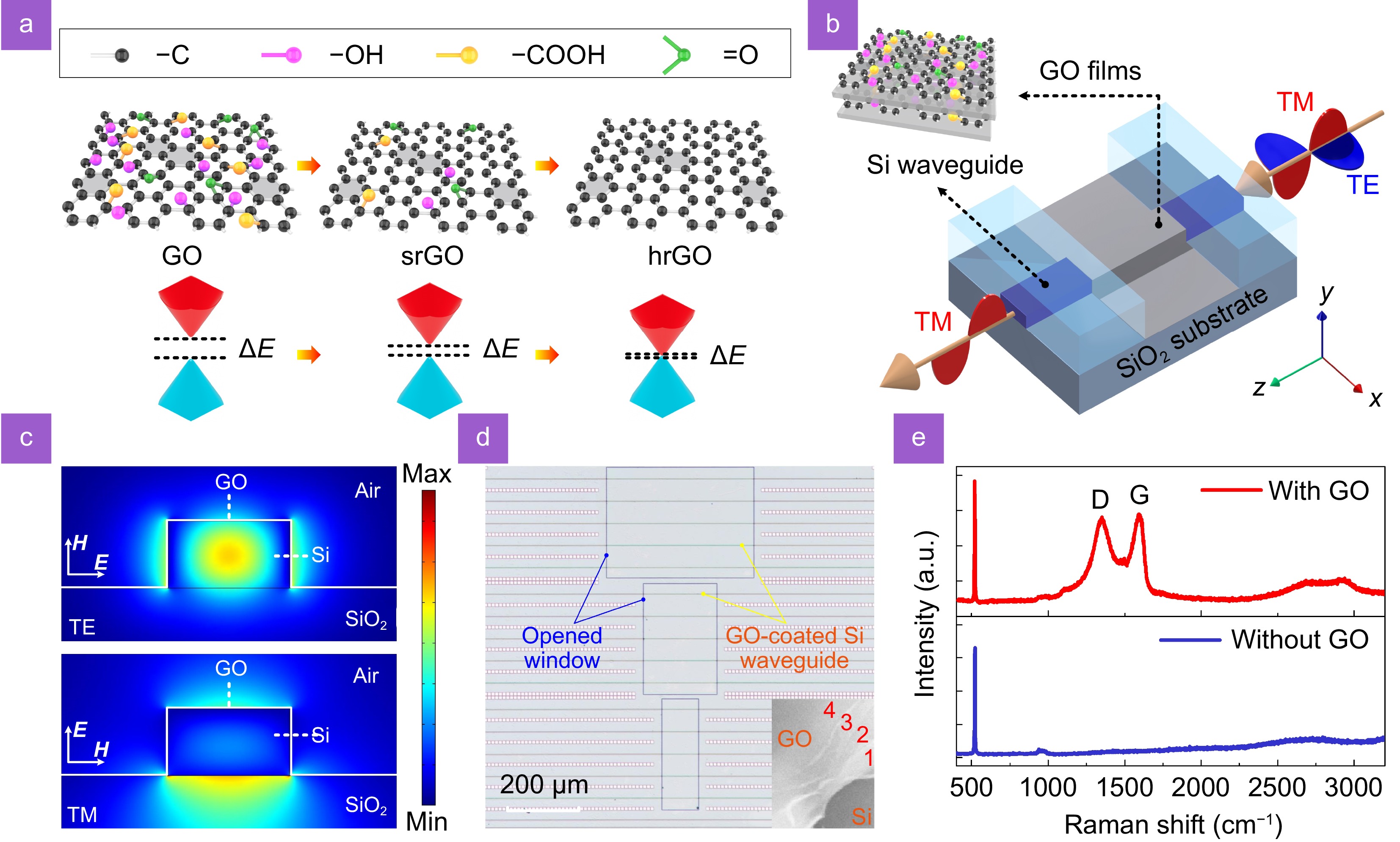

 DownLoad:
DownLoad:
